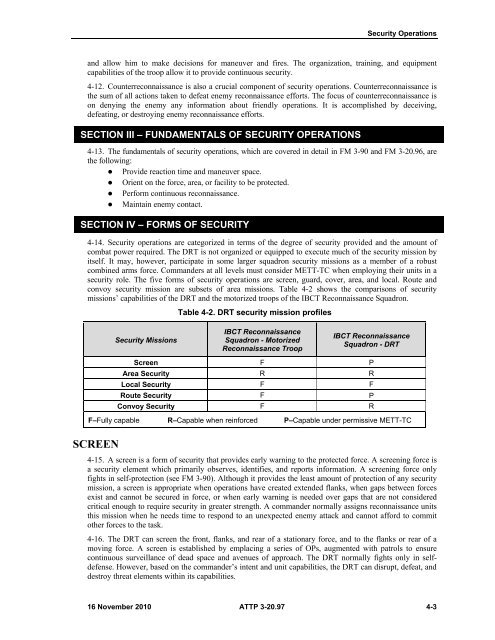Dismounted Reconnaissance Troop - Army Electronic Publications ...
Dismounted Reconnaissance Troop - Army Electronic Publications ...
Dismounted Reconnaissance Troop - Army Electronic Publications ...
You also want an ePaper? Increase the reach of your titles
YUMPU automatically turns print PDFs into web optimized ePapers that Google loves.
Security Operations<br />
and allow him to make decisions for maneuver and fires. The organization, training, and equipment<br />
capabilities of the troop allow it to provide continuous security.<br />
4-12. Counterreconnaissance is also a crucial component of security operations. Counterreconnaissance is<br />
the sum of all actions taken to defeat enemy reconnaissance efforts. The focus of counterreconnaissance is<br />
on denying the enemy any information about friendly operations. It is accomplished by deceiving,<br />
defeating, or destroying enemy reconnaissance efforts.<br />
SECTION III – FUNDAMENTALS OF SECURITY OPERATIONS<br />
4-13. The fundamentals of security operations, which are covered in detail in FM 3-90 and FM 3-20.96, are<br />
the following:<br />
Provide reaction time and maneuver space.<br />
Orient on the force, area, or facility to be protected.<br />
Perform continuous reconnaissance.<br />
Maintain enemy contact.<br />
SECTION IV – FORMS OF SECURITY<br />
4-14. Security operations are categorized in terms of the degree of security provided and the amount of<br />
combat power required. The DRT is not organized or equipped to execute much of the security mission by<br />
itself. It may, however, participate in some larger squadron security missions as a member of a robust<br />
combined arms force. Commanders at all levels must consider METT-TC when employing their units in a<br />
security role. The five forms of security operations are screen, guard, cover, area, and local. Route and<br />
convoy security mission are subsets of area missions. Table 4-2 shows the comparisons of security<br />
missions’ capabilities of the DRT and the motorized troops of the IBCT <strong>Reconnaissance</strong> Squadron.<br />
Table 4-2. DRT security mission profiles<br />
Security Missions<br />
IBCT <strong>Reconnaissance</strong><br />
Squadron - Motorized<br />
<strong>Reconnaissance</strong> <strong>Troop</strong><br />
IBCT <strong>Reconnaissance</strong><br />
Squadron - DRT<br />
Screen F P<br />
Area Security R R<br />
Local Security F F<br />
Route Security F P<br />
Convoy Security F R<br />
F–Fully capable R–Capable when reinforced P–Capable under permissive METT-TC<br />
SCREEN<br />
4-15. A screen is a form of security that provides early warning to the protected force. A screening force is<br />
a security element which primarily observes, identifies, and reports information. A screening force only<br />
fights in self-protection (see FM 3-90). Although it provides the least amount of protection of any security<br />
mission, a screen is appropriate when operations have created extended flanks, when gaps between forces<br />
exist and cannot be secured in force, or when early warning is needed over gaps that are not considered<br />
critical enough to require security in greater strength. A commander normally assigns reconnaissance units<br />
this mission when he needs time to respond to an unexpected enemy attack and cannot afford to commit<br />
other forces to the task.<br />
4-16. The DRT can screen the front, flanks, and rear of a stationary force, and to the flanks or rear of a<br />
moving force. A screen is established by emplacing a series of OPs, augmented with patrols to ensure<br />
continuous surveillance of dead space and avenues of approach. The DRT normally fights only in selfdefense.<br />
However, based on the commander’s intent and unit capabilities, the DRT can disrupt, defeat, and<br />
destroy threat elements within its capabilities.<br />
16 November 2010 ATTP 3-20.97 4-3

















